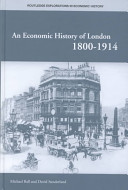An Economic History of London 1800 1914 1st Edition by Michael Ball, David Sunderland 0415406404 9780415406406
$50.00 Original price was: $50.00.$35.00Current price is: $35.00.
An Economic History of London 1800 1914 1st Edition by Michael Ball, David Sunderland – Ebook PDF Instant Download/Delivery: 0415406404, 9780415406406
Full download An Economic History of London 1800 1914 1st Edition after payment

Product details:
ISBN 10: 0415406404
ISBN 13: 9780415406406
Author: Michael Ball, David Sunderland
In 1800 London was already the largest city in the world, and over the course of the next century its population grew rapidly, reaching over seven million by 1914. Historians have often depicted London after the Industrial Revolution as an industrial backwater that declined into the mass exploitation of labour through ‘sweating’, dominated by City
An Economic History of London 1800 1914 1st Table of contents:
Part 1: Economics and urban history
1 This city
The economic dimension
The structure of the book
Defining London
2 Economics and London’s history
Introduction
Transport
Scale economies
Agglomeration economies and diseconomies
The costs of urban growth
The significance of path dependency and institutions
Urban infrastructure
London in the British economy
Conclusion
Part 2: London’s economy and people
3 Population and migration
Introduction
Size and growth
Explaining the growth of London’s population
Birth rates
Migration
Emigration
4 Work and industry
Introduction
Using the employment data from the census
Employment
Sexual divisions of labour
The concentration of industries in London
The size of firms
The changing structure of London’s industry
5 Wealth, living standards and poverty
Introduction
Wealth
Middle-class income
The distribution of income and wealth: the national context
Working-class living standards and the cost of living
Wages
Annual earnings
The regularity of pay and employment
Conclusions on the standard of living
London wages and regional convergence
Poverty
Conclusions about poverty
Part 3: The transformation of London
6 Retailing and the new mass market
Introduction
Costermongers and hawkers
Street markets
Milk
Shops
Bread-making
Branded goods
The rise of the multiple
Vertical integration
London’s retail co-operatives
Department stores
The impact of shops
7 Leisure and pleasure
Introduction
Drinking and brewing
Hotels
Eating out
Spectacles: hangings, fairs and pleasure gardens
Theatres, music halls and cinemas
Museum and church attendance
Piano and organ manufacture
Reading, printing and publishing
Conclusion
8 Suburbanisation and housing
Introduction
The spread of the suburbs
Housing development
Part 4: Infrastructure
9 To and from the capital
Introduction
Horse-drawn transport
Boats and ships
Railways
The Port of London
10 Moving around London
Introduction
The pedestrian city
Horses and carriages
The growth of public transport and congestion
Coaches and hackney cabs
Steamboats
Buses
Trains
Trams
The underground
11 Utilities, communications and markets
Introduction
Water
Gas
Electricity supply
Post and telecommunications
Wholesale markets
Part 5: Industrial and commercial change
12 Manufacturing
Introduction
A new sub-contracting system
Some economics of nineteenth-century consumer goods production
Wages
The clothing industries
Silk weaving
Footwear manufacture
Furniture manufacture
Engineering
Industrial and building materials
13 Domestic, clerical and professional services
Introduction
Domestic service
The growth of laundry services
Clerks
Professions
14 Financial services and the City
Introduction
Banking, discounting and the money market
The impact of distance on nineteenth-century financial markets
Stocks and shares
Insurance
Commercial trade
The redevelopment of the City
Part 6: Welfare and government
15 Welfare and social policy
Introduction
Health care
Income support
The causes and relief of poverty
Employment and wages policies
Housing the poor
16 The government of London
Introduction
Some economics of local government
Reform passed by: before 1855
The two-tier system from 1855 to 1889
The London County Council years, 1889–1914
Part 7: An assessment
17 Conclusions
Introduction
A centre of industry
London’s service economy
The standard of living and poverty
Public transport and the utilities
Local government and real estate
Was London too big?
Notes
1 This city
2 Economics and London’s history
3 Population and migration
4 Work and industry
5 Wealth, living standards and poverty
6 Retailing and the new mass market
7 Leisure and pleasure
8 Suburbanisation and housing
9 To and from the capital
10 Moving around London
11 Utilities, communications and markets
12 Manufacturing
13 Domestic, clerical and professional services
14 Financial services and the City
15 Welfare and social policy
16 The government of London
17 Conclusions
Bibliography
Parliamentary Papers
Books and articles
People also search for An Economic History of London 1800 1914 1st:
an economic history of the world since 1400
1800 to london
an economic history of the ussr pdf
victorian era london facts
Tags:
Michael Ball,David Sunderland,Economic,History



